The Essay on Mass Tourism Assessment
VerifiedAdded on 2022/08/08
|6
|2123
|16
AI Summary
Contribute Materials
Your contribution can guide someone’s learning journey. Share your
documents today.
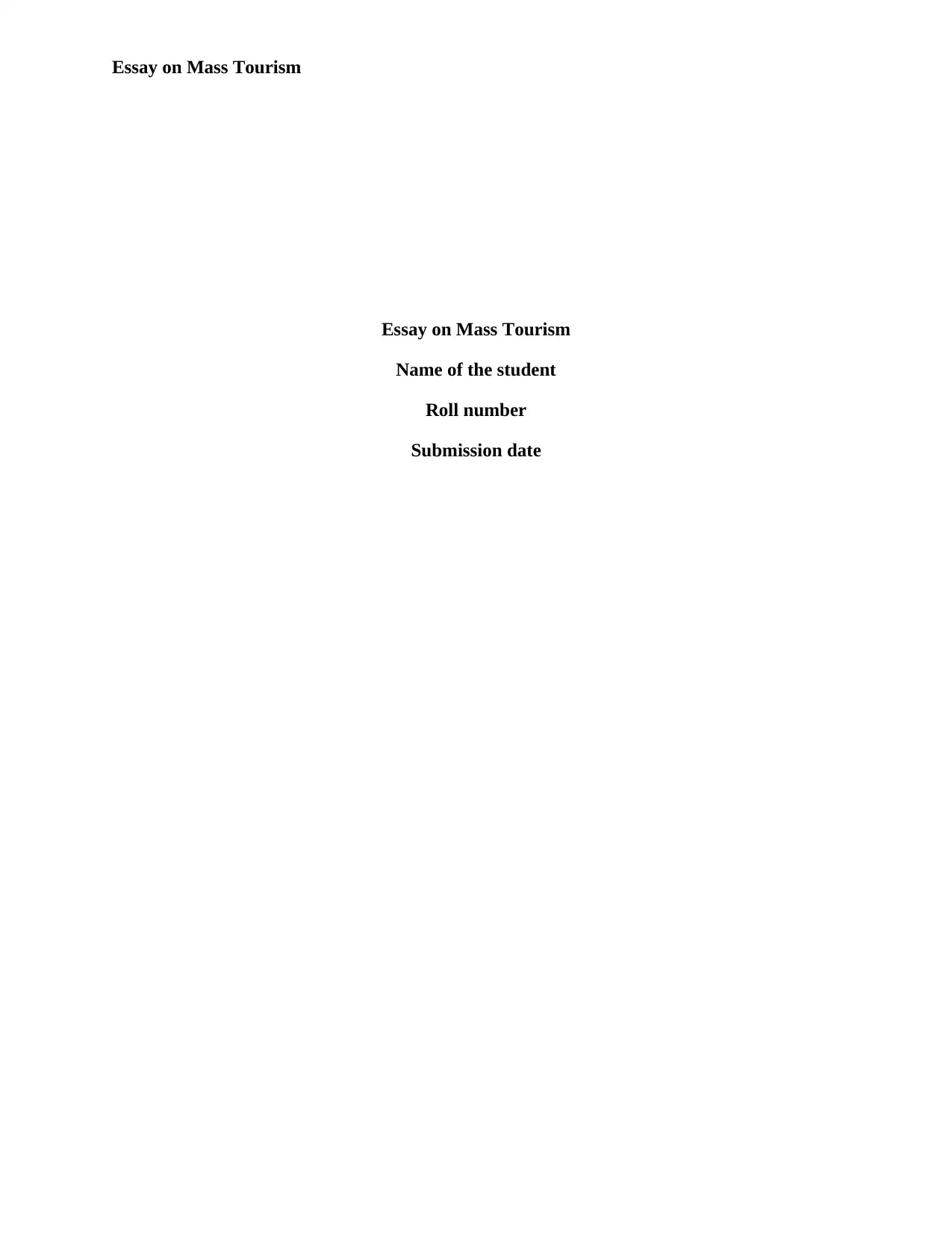
Essay on Mass Tourism
Essay on Mass Tourism
Name of the student
Roll number
Submission date
Essay on Mass Tourism
Name of the student
Roll number
Submission date
Secure Best Marks with AI Grader
Need help grading? Try our AI Grader for instant feedback on your assignments.
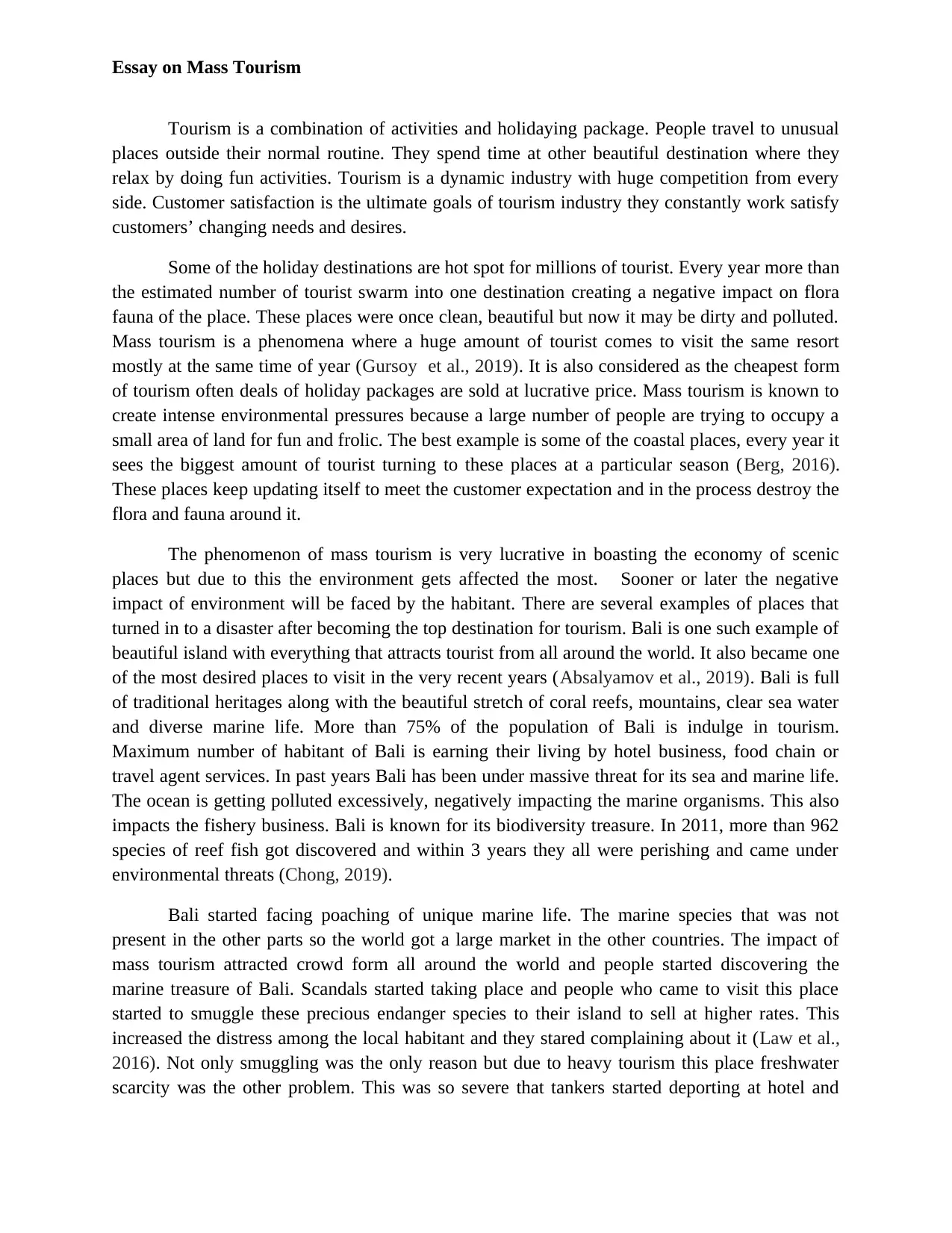
Essay on Mass Tourism
Tourism is a combination of activities and holidaying package. People travel to unusual
places outside their normal routine. They spend time at other beautiful destination where they
relax by doing fun activities. Tourism is a dynamic industry with huge competition from every
side. Customer satisfaction is the ultimate goals of tourism industry they constantly work satisfy
customers’ changing needs and desires.
Some of the holiday destinations are hot spot for millions of tourist. Every year more than
the estimated number of tourist swarm into one destination creating a negative impact on flora
fauna of the place. These places were once clean, beautiful but now it may be dirty and polluted.
Mass tourism is a phenomena where a huge amount of tourist comes to visit the same resort
mostly at the same time of year (Gursoy et al., 2019). It is also considered as the cheapest form
of tourism often deals of holiday packages are sold at lucrative price. Mass tourism is known to
create intense environmental pressures because a large number of people are trying to occupy a
small area of land for fun and frolic. The best example is some of the coastal places, every year it
sees the biggest amount of tourist turning to these places at a particular season (Berg, 2016).
These places keep updating itself to meet the customer expectation and in the process destroy the
flora and fauna around it.
The phenomenon of mass tourism is very lucrative in boasting the economy of scenic
places but due to this the environment gets affected the most. Sooner or later the negative
impact of environment will be faced by the habitant. There are several examples of places that
turned in to a disaster after becoming the top destination for tourism. Bali is one such example of
beautiful island with everything that attracts tourist from all around the world. It also became one
of the most desired places to visit in the very recent years (Absalyamov et al., 2019). Bali is full
of traditional heritages along with the beautiful stretch of coral reefs, mountains, clear sea water
and diverse marine life. More than 75% of the population of Bali is indulge in tourism.
Maximum number of habitant of Bali is earning their living by hotel business, food chain or
travel agent services. In past years Bali has been under massive threat for its sea and marine life.
The ocean is getting polluted excessively, negatively impacting the marine organisms. This also
impacts the fishery business. Bali is known for its biodiversity treasure. In 2011, more than 962
species of reef fish got discovered and within 3 years they all were perishing and came under
environmental threats (Chong, 2019).
Bali started facing poaching of unique marine life. The marine species that was not
present in the other parts so the world got a large market in the other countries. The impact of
mass tourism attracted crowd form all around the world and people started discovering the
marine treasure of Bali. Scandals started taking place and people who came to visit this place
started to smuggle these precious endanger species to their island to sell at higher rates. This
increased the distress among the local habitant and they stared complaining about it (Law et al.,
2016). Not only smuggling was the only reason but due to heavy tourism this place freshwater
scarcity was the other problem. This was so severe that tankers started deporting at hotel and
Tourism is a combination of activities and holidaying package. People travel to unusual
places outside their normal routine. They spend time at other beautiful destination where they
relax by doing fun activities. Tourism is a dynamic industry with huge competition from every
side. Customer satisfaction is the ultimate goals of tourism industry they constantly work satisfy
customers’ changing needs and desires.
Some of the holiday destinations are hot spot for millions of tourist. Every year more than
the estimated number of tourist swarm into one destination creating a negative impact on flora
fauna of the place. These places were once clean, beautiful but now it may be dirty and polluted.
Mass tourism is a phenomena where a huge amount of tourist comes to visit the same resort
mostly at the same time of year (Gursoy et al., 2019). It is also considered as the cheapest form
of tourism often deals of holiday packages are sold at lucrative price. Mass tourism is known to
create intense environmental pressures because a large number of people are trying to occupy a
small area of land for fun and frolic. The best example is some of the coastal places, every year it
sees the biggest amount of tourist turning to these places at a particular season (Berg, 2016).
These places keep updating itself to meet the customer expectation and in the process destroy the
flora and fauna around it.
The phenomenon of mass tourism is very lucrative in boasting the economy of scenic
places but due to this the environment gets affected the most. Sooner or later the negative
impact of environment will be faced by the habitant. There are several examples of places that
turned in to a disaster after becoming the top destination for tourism. Bali is one such example of
beautiful island with everything that attracts tourist from all around the world. It also became one
of the most desired places to visit in the very recent years (Absalyamov et al., 2019). Bali is full
of traditional heritages along with the beautiful stretch of coral reefs, mountains, clear sea water
and diverse marine life. More than 75% of the population of Bali is indulge in tourism.
Maximum number of habitant of Bali is earning their living by hotel business, food chain or
travel agent services. In past years Bali has been under massive threat for its sea and marine life.
The ocean is getting polluted excessively, negatively impacting the marine organisms. This also
impacts the fishery business. Bali is known for its biodiversity treasure. In 2011, more than 962
species of reef fish got discovered and within 3 years they all were perishing and came under
environmental threats (Chong, 2019).
Bali started facing poaching of unique marine life. The marine species that was not
present in the other parts so the world got a large market in the other countries. The impact of
mass tourism attracted crowd form all around the world and people started discovering the
marine treasure of Bali. Scandals started taking place and people who came to visit this place
started to smuggle these precious endanger species to their island to sell at higher rates. This
increased the distress among the local habitant and they stared complaining about it (Law et al.,
2016). Not only smuggling was the only reason but due to heavy tourism this place freshwater
scarcity was the other problem. This was so severe that tankers started deporting at hotel and
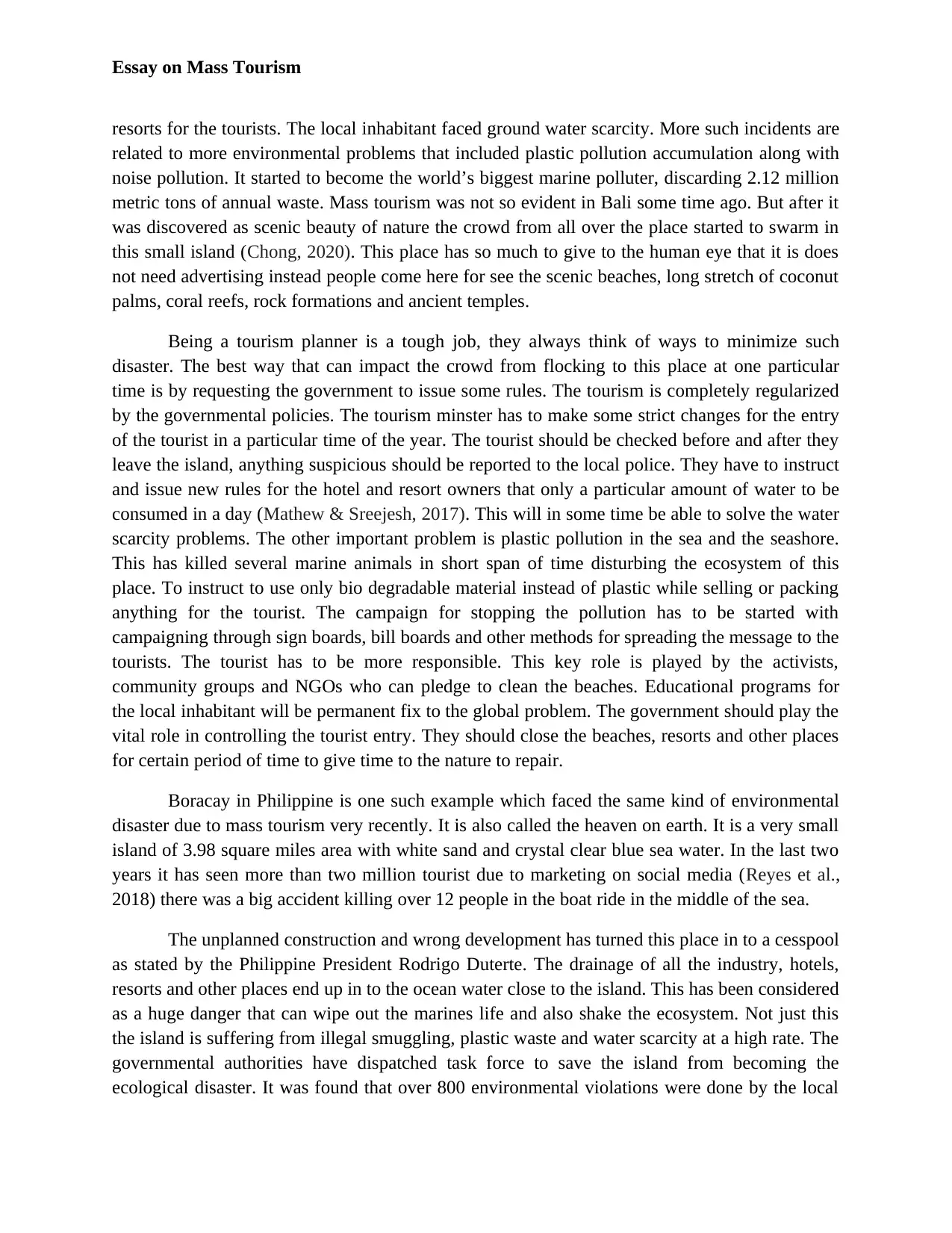
Essay on Mass Tourism
resorts for the tourists. The local inhabitant faced ground water scarcity. More such incidents are
related to more environmental problems that included plastic pollution accumulation along with
noise pollution. It started to become the world’s biggest marine polluter, discarding 2.12 million
metric tons of annual waste. Mass tourism was not so evident in Bali some time ago. But after it
was discovered as scenic beauty of nature the crowd from all over the place started to swarm in
this small island (Chong, 2020). This place has so much to give to the human eye that it is does
not need advertising instead people come here for see the scenic beaches, long stretch of coconut
palms, coral reefs, rock formations and ancient temples.
Being a tourism planner is a tough job, they always think of ways to minimize such
disaster. The best way that can impact the crowd from flocking to this place at one particular
time is by requesting the government to issue some rules. The tourism is completely regularized
by the governmental policies. The tourism minster has to make some strict changes for the entry
of the tourist in a particular time of the year. The tourist should be checked before and after they
leave the island, anything suspicious should be reported to the local police. They have to instruct
and issue new rules for the hotel and resort owners that only a particular amount of water to be
consumed in a day (Mathew & Sreejesh, 2017). This will in some time be able to solve the water
scarcity problems. The other important problem is plastic pollution in the sea and the seashore.
This has killed several marine animals in short span of time disturbing the ecosystem of this
place. To instruct to use only bio degradable material instead of plastic while selling or packing
anything for the tourist. The campaign for stopping the pollution has to be started with
campaigning through sign boards, bill boards and other methods for spreading the message to the
tourists. The tourist has to be more responsible. This key role is played by the activists,
community groups and NGOs who can pledge to clean the beaches. Educational programs for
the local inhabitant will be permanent fix to the global problem. The government should play the
vital role in controlling the tourist entry. They should close the beaches, resorts and other places
for certain period of time to give time to the nature to repair.
Boracay in Philippine is one such example which faced the same kind of environmental
disaster due to mass tourism very recently. It is also called the heaven on earth. It is a very small
island of 3.98 square miles area with white sand and crystal clear blue sea water. In the last two
years it has seen more than two million tourist due to marketing on social media (Reyes et al.,
2018) there was a big accident killing over 12 people in the boat ride in the middle of the sea.
The unplanned construction and wrong development has turned this place in to a cesspool
as stated by the Philippine President Rodrigo Duterte. The drainage of all the industry, hotels,
resorts and other places end up in to the ocean water close to the island. This has been considered
as a huge danger that can wipe out the marines life and also shake the ecosystem. Not just this
the island is suffering from illegal smuggling, plastic waste and water scarcity at a high rate. The
governmental authorities have dispatched task force to save the island from becoming the
ecological disaster. It was found that over 800 environmental violations were done by the local
resorts for the tourists. The local inhabitant faced ground water scarcity. More such incidents are
related to more environmental problems that included plastic pollution accumulation along with
noise pollution. It started to become the world’s biggest marine polluter, discarding 2.12 million
metric tons of annual waste. Mass tourism was not so evident in Bali some time ago. But after it
was discovered as scenic beauty of nature the crowd from all over the place started to swarm in
this small island (Chong, 2020). This place has so much to give to the human eye that it is does
not need advertising instead people come here for see the scenic beaches, long stretch of coconut
palms, coral reefs, rock formations and ancient temples.
Being a tourism planner is a tough job, they always think of ways to minimize such
disaster. The best way that can impact the crowd from flocking to this place at one particular
time is by requesting the government to issue some rules. The tourism is completely regularized
by the governmental policies. The tourism minster has to make some strict changes for the entry
of the tourist in a particular time of the year. The tourist should be checked before and after they
leave the island, anything suspicious should be reported to the local police. They have to instruct
and issue new rules for the hotel and resort owners that only a particular amount of water to be
consumed in a day (Mathew & Sreejesh, 2017). This will in some time be able to solve the water
scarcity problems. The other important problem is plastic pollution in the sea and the seashore.
This has killed several marine animals in short span of time disturbing the ecosystem of this
place. To instruct to use only bio degradable material instead of plastic while selling or packing
anything for the tourist. The campaign for stopping the pollution has to be started with
campaigning through sign boards, bill boards and other methods for spreading the message to the
tourists. The tourist has to be more responsible. This key role is played by the activists,
community groups and NGOs who can pledge to clean the beaches. Educational programs for
the local inhabitant will be permanent fix to the global problem. The government should play the
vital role in controlling the tourist entry. They should close the beaches, resorts and other places
for certain period of time to give time to the nature to repair.
Boracay in Philippine is one such example which faced the same kind of environmental
disaster due to mass tourism very recently. It is also called the heaven on earth. It is a very small
island of 3.98 square miles area with white sand and crystal clear blue sea water. In the last two
years it has seen more than two million tourist due to marketing on social media (Reyes et al.,
2018) there was a big accident killing over 12 people in the boat ride in the middle of the sea.
The unplanned construction and wrong development has turned this place in to a cesspool
as stated by the Philippine President Rodrigo Duterte. The drainage of all the industry, hotels,
resorts and other places end up in to the ocean water close to the island. This has been considered
as a huge danger that can wipe out the marines life and also shake the ecosystem. Not just this
the island is suffering from illegal smuggling, plastic waste and water scarcity at a high rate. The
governmental authorities have dispatched task force to save the island from becoming the
ecological disaster. It was found that over 800 environmental violations were done by the local
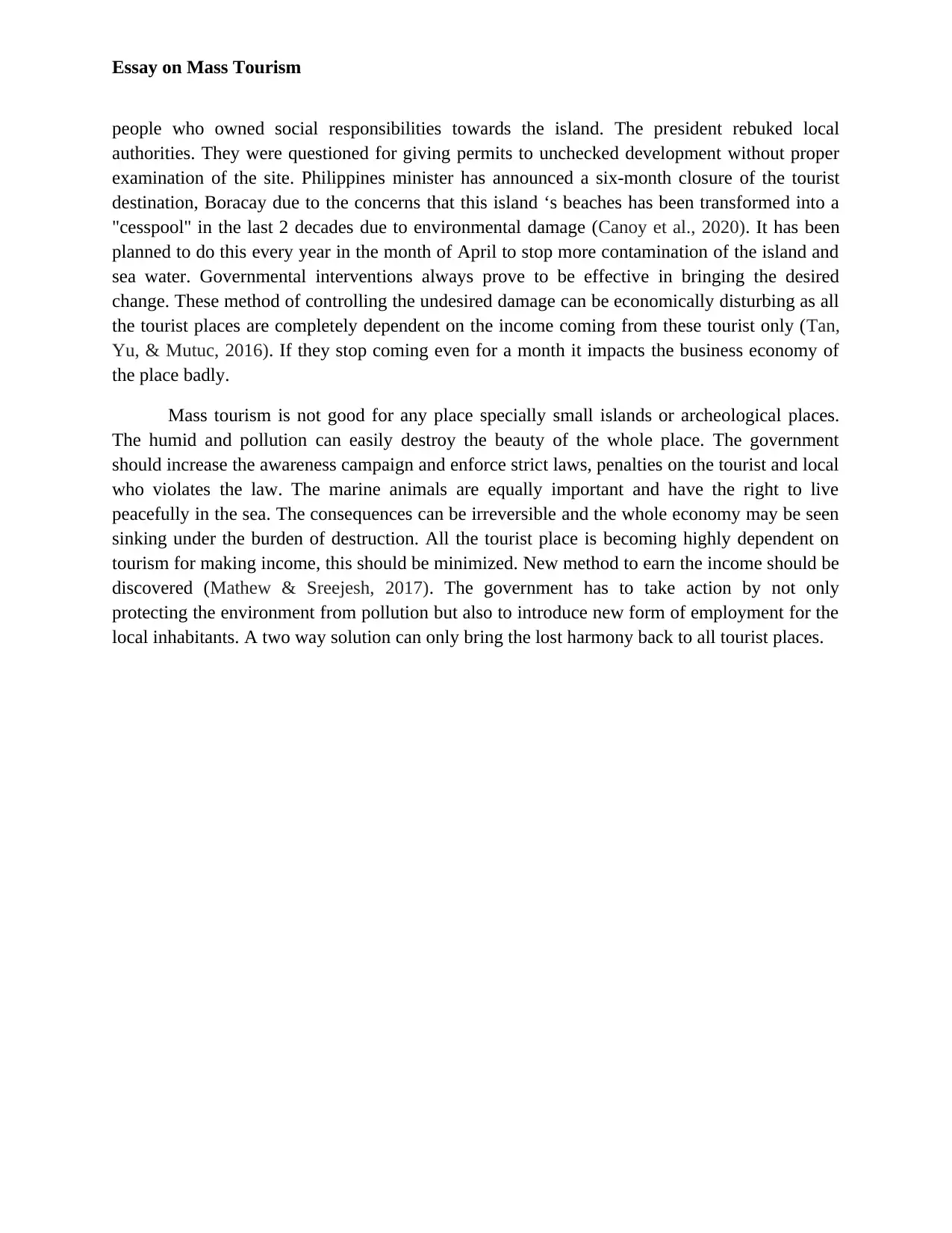
Essay on Mass Tourism
people who owned social responsibilities towards the island. The president rebuked local
authorities. They were questioned for giving permits to unchecked development without proper
examination of the site. Philippines minister has announced a six-month closure of the tourist
destination, Boracay due to the concerns that this island ‘s beaches has been transformed into a
"cesspool" in the last 2 decades due to environmental damage (Canoy et al., 2020). It has been
planned to do this every year in the month of April to stop more contamination of the island and
sea water. Governmental interventions always prove to be effective in bringing the desired
change. These method of controlling the undesired damage can be economically disturbing as all
the tourist places are completely dependent on the income coming from these tourist only (Tan,
Yu, & Mutuc, 2016). If they stop coming even for a month it impacts the business economy of
the place badly.
Mass tourism is not good for any place specially small islands or archeological places.
The humid and pollution can easily destroy the beauty of the whole place. The government
should increase the awareness campaign and enforce strict laws, penalties on the tourist and local
who violates the law. The marine animals are equally important and have the right to live
peacefully in the sea. The consequences can be irreversible and the whole economy may be seen
sinking under the burden of destruction. All the tourist place is becoming highly dependent on
tourism for making income, this should be minimized. New method to earn the income should be
discovered (Mathew & Sreejesh, 2017). The government has to take action by not only
protecting the environment from pollution but also to introduce new form of employment for the
local inhabitants. A two way solution can only bring the lost harmony back to all tourist places.
people who owned social responsibilities towards the island. The president rebuked local
authorities. They were questioned for giving permits to unchecked development without proper
examination of the site. Philippines minister has announced a six-month closure of the tourist
destination, Boracay due to the concerns that this island ‘s beaches has been transformed into a
"cesspool" in the last 2 decades due to environmental damage (Canoy et al., 2020). It has been
planned to do this every year in the month of April to stop more contamination of the island and
sea water. Governmental interventions always prove to be effective in bringing the desired
change. These method of controlling the undesired damage can be economically disturbing as all
the tourist places are completely dependent on the income coming from these tourist only (Tan,
Yu, & Mutuc, 2016). If they stop coming even for a month it impacts the business economy of
the place badly.
Mass tourism is not good for any place specially small islands or archeological places.
The humid and pollution can easily destroy the beauty of the whole place. The government
should increase the awareness campaign and enforce strict laws, penalties on the tourist and local
who violates the law. The marine animals are equally important and have the right to live
peacefully in the sea. The consequences can be irreversible and the whole economy may be seen
sinking under the burden of destruction. All the tourist place is becoming highly dependent on
tourism for making income, this should be minimized. New method to earn the income should be
discovered (Mathew & Sreejesh, 2017). The government has to take action by not only
protecting the environment from pollution but also to introduce new form of employment for the
local inhabitants. A two way solution can only bring the lost harmony back to all tourist places.
Secure Best Marks with AI Grader
Need help grading? Try our AI Grader for instant feedback on your assignments.
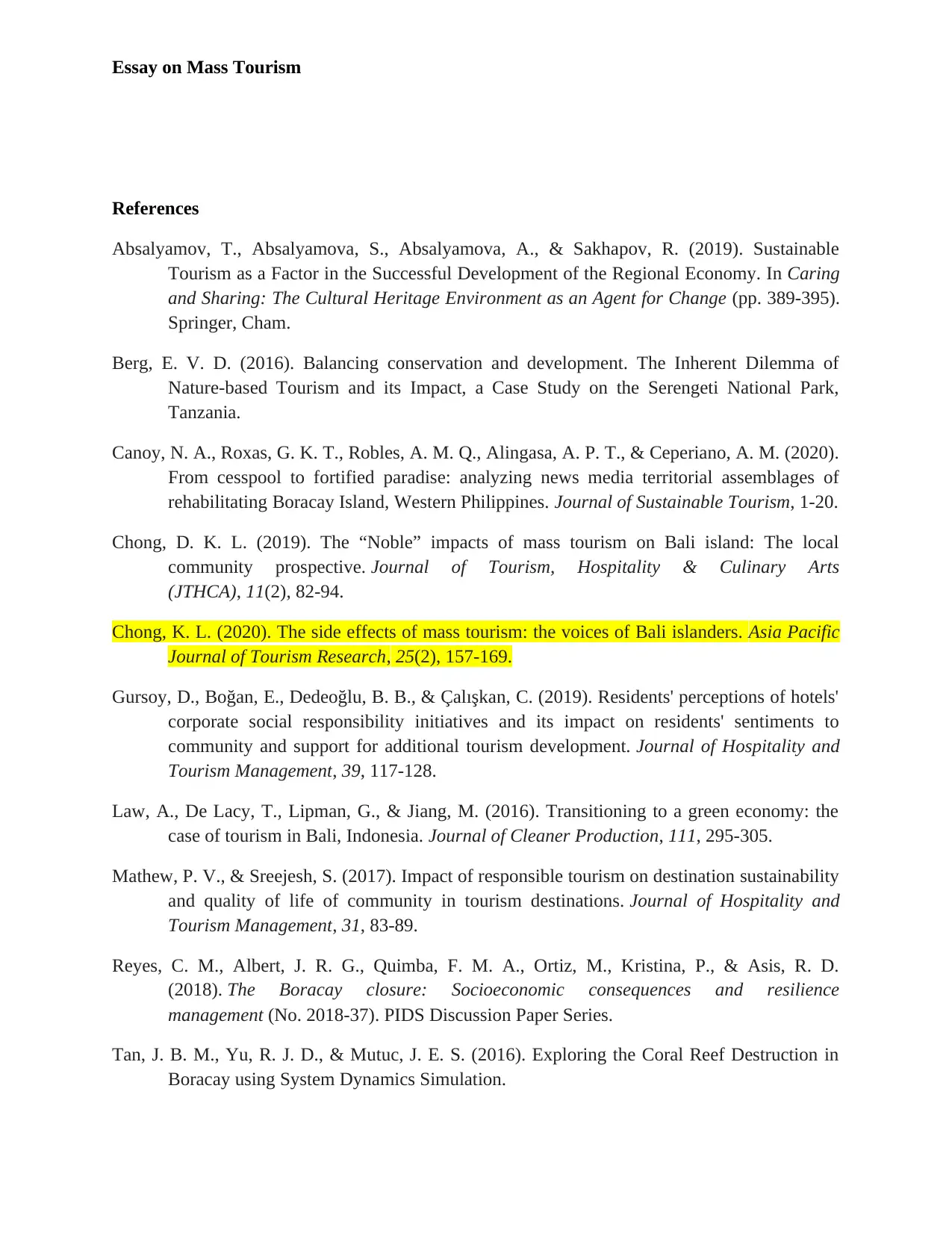
Essay on Mass Tourism
References
Absalyamov, T., Absalyamova, S., Absalyamova, A., & Sakhapov, R. (2019). Sustainable
Tourism as a Factor in the Successful Development of the Regional Economy. In Caring
and Sharing: The Cultural Heritage Environment as an Agent for Change (pp. 389-395).
Springer, Cham.
Berg, E. V. D. (2016). Balancing conservation and development. The Inherent Dilemma of
Nature-based Tourism and its Impact, a Case Study on the Serengeti National Park,
Tanzania.
Canoy, N. A., Roxas, G. K. T., Robles, A. M. Q., Alingasa, A. P. T., & Ceperiano, A. M. (2020).
From cesspool to fortified paradise: analyzing news media territorial assemblages of
rehabilitating Boracay Island, Western Philippines. Journal of Sustainable Tourism, 1-20.
Chong, D. K. L. (2019). The “Noble” impacts of mass tourism on Bali island: The local
community prospective. Journal of Tourism, Hospitality & Culinary Arts
(JTHCA), 11(2), 82-94.
Chong, K. L. (2020). The side effects of mass tourism: the voices of Bali islanders. Asia Pacific
Journal of Tourism Research, 25(2), 157-169.
Gursoy, D., Boğan, E., Dedeoğlu, B. B., & Çalışkan, C. (2019). Residents' perceptions of hotels'
corporate social responsibility initiatives and its impact on residents' sentiments to
community and support for additional tourism development. Journal of Hospitality and
Tourism Management, 39, 117-128.
Law, A., De Lacy, T., Lipman, G., & Jiang, M. (2016). Transitioning to a green economy: the
case of tourism in Bali, Indonesia. Journal of Cleaner Production, 111, 295-305.
Mathew, P. V., & Sreejesh, S. (2017). Impact of responsible tourism on destination sustainability
and quality of life of community in tourism destinations. Journal of Hospitality and
Tourism Management, 31, 83-89.
Reyes, C. M., Albert, J. R. G., Quimba, F. M. A., Ortiz, M., Kristina, P., & Asis, R. D.
(2018). The Boracay closure: Socioeconomic consequences and resilience
management (No. 2018-37). PIDS Discussion Paper Series.
Tan, J. B. M., Yu, R. J. D., & Mutuc, J. E. S. (2016). Exploring the Coral Reef Destruction in
Boracay using System Dynamics Simulation.
References
Absalyamov, T., Absalyamova, S., Absalyamova, A., & Sakhapov, R. (2019). Sustainable
Tourism as a Factor in the Successful Development of the Regional Economy. In Caring
and Sharing: The Cultural Heritage Environment as an Agent for Change (pp. 389-395).
Springer, Cham.
Berg, E. V. D. (2016). Balancing conservation and development. The Inherent Dilemma of
Nature-based Tourism and its Impact, a Case Study on the Serengeti National Park,
Tanzania.
Canoy, N. A., Roxas, G. K. T., Robles, A. M. Q., Alingasa, A. P. T., & Ceperiano, A. M. (2020).
From cesspool to fortified paradise: analyzing news media territorial assemblages of
rehabilitating Boracay Island, Western Philippines. Journal of Sustainable Tourism, 1-20.
Chong, D. K. L. (2019). The “Noble” impacts of mass tourism on Bali island: The local
community prospective. Journal of Tourism, Hospitality & Culinary Arts
(JTHCA), 11(2), 82-94.
Chong, K. L. (2020). The side effects of mass tourism: the voices of Bali islanders. Asia Pacific
Journal of Tourism Research, 25(2), 157-169.
Gursoy, D., Boğan, E., Dedeoğlu, B. B., & Çalışkan, C. (2019). Residents' perceptions of hotels'
corporate social responsibility initiatives and its impact on residents' sentiments to
community and support for additional tourism development. Journal of Hospitality and
Tourism Management, 39, 117-128.
Law, A., De Lacy, T., Lipman, G., & Jiang, M. (2016). Transitioning to a green economy: the
case of tourism in Bali, Indonesia. Journal of Cleaner Production, 111, 295-305.
Mathew, P. V., & Sreejesh, S. (2017). Impact of responsible tourism on destination sustainability
and quality of life of community in tourism destinations. Journal of Hospitality and
Tourism Management, 31, 83-89.
Reyes, C. M., Albert, J. R. G., Quimba, F. M. A., Ortiz, M., Kristina, P., & Asis, R. D.
(2018). The Boracay closure: Socioeconomic consequences and resilience
management (No. 2018-37). PIDS Discussion Paper Series.
Tan, J. B. M., Yu, R. J. D., & Mutuc, J. E. S. (2016). Exploring the Coral Reef Destruction in
Boracay using System Dynamics Simulation.

Essay on Mass Tourism
1 out of 6
Related Documents
Your All-in-One AI-Powered Toolkit for Academic Success.
+13062052269
info@desklib.com
Available 24*7 on WhatsApp / Email
![[object Object]](/_next/static/media/star-bottom.7253800d.svg)
Unlock your academic potential
© 2024 | Zucol Services PVT LTD | All rights reserved.





